Bowen Jin
Search-R1: Training LLMs to Reason and Leverage Search Engines with Reinforcement Learning
Mar 12, 2025Abstract:Efficiently acquiring external knowledge and up-to-date information is essential for effective reasoning and text generation in large language models (LLMs). Retrieval augmentation and tool-use training approaches where a search engine is treated as a tool lack complex multi-turn retrieval flexibility or require large-scale supervised data. Prompting advanced LLMs with reasoning capabilities during inference to use search engines is not optimal, since the LLM does not learn how to optimally interact with the search engine. This paper introduces Search-R1, an extension of the DeepSeek-R1 model where the LLM learns -- solely through reinforcement learning (RL) -- to autonomously generate (multiple) search queries during step-by-step reasoning with real-time retrieval. Search-R1 optimizes LLM rollouts with multi-turn search interactions, leveraging retrieved token masking for stable RL training and a simple outcome-based reward function. Experiments on seven question-answering datasets show that Search-R1 improves performance by 26% (Qwen2.5-7B), 21% (Qwen2.5-3B), and 10% (LLaMA3.2-3B) over SOTA baselines. This paper further provides empirical insights into RL optimization methods, LLM choices, and response length dynamics in retrieval-augmented reasoning. The code and model checkpoints are available at https://github.com/PeterGriffinJin/Search-R1.
GRAPHGPT-O: Synergistic Multimodal Comprehension and Generation on Graphs
Feb 17, 2025Abstract:The rapid development of Multimodal Large Language Models (MLLMs) has enabled the integration of multiple modalities, including texts and images, within the large language model (LLM) framework. However, texts and images are usually interconnected, forming a multimodal attributed graph (MMAG). It is underexplored how MLLMs can incorporate the relational information (\textit{i.e.}, graph structure) and semantic information (\textit{i.e.,} texts and images) on such graphs for multimodal comprehension and generation. In this paper, we propose GraphGPT-o, which supports omni-multimodal understanding and creation on MMAGs. We first comprehensively study linearization variants to transform semantic and structural information as input for MLLMs. Then, we propose a hierarchical aligner that enables deep graph encoding, bridging the gap between MMAGs and MLLMs. Finally, we explore the inference choices, adapting MLLM to interleaved text and image generation in graph scenarios. Extensive experiments on three datasets from different domains demonstrate the effectiveness of our proposed method. Datasets and codes will be open-sourced upon acceptance.
LLM Alignment as Retriever Optimization: An Information Retrieval Perspective
Feb 06, 2025



Abstract:Large Language Models (LLMs) have revolutionized artificial intelligence with capabilities in reasoning, coding, and communication, driving innovation across industries. Their true potential depends on effective alignment to ensure correct, trustworthy and ethical behavior, addressing challenges like misinformation, hallucinations, bias and misuse. While existing Reinforcement Learning (RL)-based alignment methods are notoriously complex, direct optimization approaches offer a simpler alternative. In this work, we introduce a novel direct optimization approach for LLM alignment by drawing on established Information Retrieval (IR) principles. We present a systematic framework that bridges LLM alignment and IR methodologies, mapping LLM generation and reward models to IR's retriever-reranker paradigm. Building on this foundation, we propose LLM Alignment as Retriever Preference Optimization (LarPO), a new alignment method that enhances overall alignment quality. Extensive experiments validate LarPO's effectiveness with 38.9 % and 13.7 % averaged improvement on AlpacaEval2 and MixEval-Hard respectively. Our work opens new avenues for advancing LLM alignment by integrating IR foundations, offering a promising direction for future research.
Deep Learning and Foundation Models for Weather Prediction: A Survey
Jan 12, 2025Abstract:Physics-based numerical models have been the bedrock of atmospheric sciences for decades, offering robust solutions but often at the cost of significant computational resources. Deep learning (DL) models have emerged as powerful tools in meteorology, capable of analyzing complex weather and climate data by learning intricate dependencies and providing rapid predictions once trained. While these models demonstrate promising performance in weather prediction, often surpassing traditional physics-based methods, they still face critical challenges. This paper presents a comprehensive survey of recent deep learning and foundation models for weather prediction. We propose a taxonomy to classify existing models based on their training paradigms: deterministic predictive learning, probabilistic generative learning, and pre-training and fine-tuning. For each paradigm, we delve into the underlying model architectures, address major challenges, offer key insights, and propose targeted directions for future research. Furthermore, we explore real-world applications of these methods and provide a curated summary of open-source code repositories and widely used datasets, aiming to bridge research advancements with practical implementations while fostering open and trustworthy scientific practices in adopting cutting-edge artificial intelligence for weather prediction. The related sources are available at https://github.com/JimengShi/ DL-Foundation-Models-Weather.
Can Graph Neural Networks Learn Language with Extremely Weak Text Supervision?
Dec 11, 2024



Abstract:While great success has been achieved in building vision models with Contrastive Language-Image Pre-training (CLIP) over Internet-scale image-text pairs, building transferable Graph Neural Networks (GNNs) with CLIP pipeline is challenging because of three fundamental issues: the scarcity of labeled data and text supervision, different levels of downstream tasks, and the conceptual gaps between domains. In this work, to address these issues, we leverage multi-modal prompt learning to effectively adapt pre-trained GNN to downstream tasks and data, given only a few semantically labeled samples, each with extremely weak text supervision. Our new paradigm embeds the graphs directly in the same space as the Large Language Models (LLMs) by learning both graph prompts and text prompts simultaneously. To accomplish this, we improve state-of-the-art graph prompt method, and then propose the first graph-language multi-modal prompt learning approach for exploiting the knowledge in pre-trained models. Notably, due to the insufficient supervision for fine-tuning, in our paradigm, the pre-trained GNN and the LLM are kept frozen, so the learnable parameters are much fewer than fine-tuning any pre-trained model. Through extensive experiments on real-world datasets, we demonstrate the superior performance of our paradigm in few-shot, multi-task-level, and cross-domain settings. Moreover, we build the first CLIP-style zero-shot classification prototype that can generalize GNNs to unseen classes with extremely weak text supervision.
InstructG2I: Synthesizing Images from Multimodal Attributed Graphs
Oct 09, 2024



Abstract:In this paper, we approach an overlooked yet critical task Graph2Image: generating images from multimodal attributed graphs (MMAGs). This task poses significant challenges due to the explosion in graph size, dependencies among graph entities, and the need for controllability in graph conditions. To address these challenges, we propose a graph context-conditioned diffusion model called InstructG2I. InstructG2I first exploits the graph structure and multimodal information to conduct informative neighbor sampling by combining personalized page rank and re-ranking based on vision-language features. Then, a Graph-QFormer encoder adaptively encodes the graph nodes into an auxiliary set of graph prompts to guide the denoising process of diffusion. Finally, we propose graph classifier-free guidance, enabling controllable generation by varying the strength of graph guidance and multiple connected edges to a node. Extensive experiments conducted on three datasets from different domains demonstrate the effectiveness and controllability of our approach. The code is available at https://github.com/PeterGriffinJin/InstructG2I.
* 16 pages
Long-Context LLMs Meet RAG: Overcoming Challenges for Long Inputs in RAG
Oct 08, 2024



Abstract:Retrieval-augmented generation (RAG) empowers large language models (LLMs) to utilize external knowledge sources. The increasing capacity of LLMs to process longer input sequences opens up avenues for providing more retrieved information, to potentially enhance the quality of generated outputs. It is plausible to assume that a larger retrieval set would contain more relevant information (higher recall), that might result in improved performance. However, our empirical findings demonstrate that for many long-context LLMs, the quality of generated output initially improves first, but then subsequently declines as the number of retrieved passages increases. This paper investigates this phenomenon, identifying the detrimental impact of retrieved "hard negatives" as a key contributor. To mitigate this and enhance the robustness of long-context LLM-based RAG, we propose both training-free and training-based approaches. We first showcase the effectiveness of retrieval reordering as a simple yet powerful training-free optimization. Furthermore, we explore training-based methods, specifically RAG-specific implicit LLM fine-tuning and RAG-oriented fine-tuning with intermediate reasoning, demonstrating their capacity for substantial performance gains. Finally, we conduct a systematic analysis of design choices for these training-based methods, including data distribution, retriever selection, and training context length.
CoDiCast: Conditional Diffusion Model for Weather Prediction with Uncertainty Quantification
Sep 09, 2024

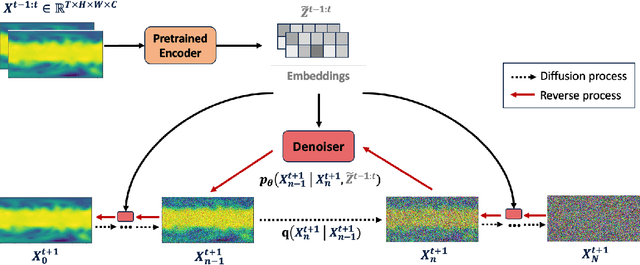
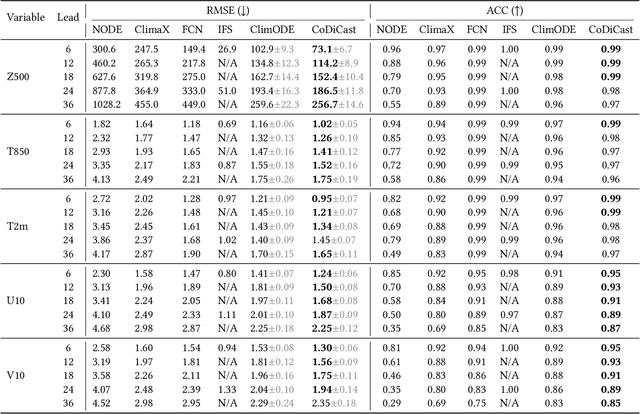
Abstract:Accurate weather forecasting is critical for science and society. Yet, existing methods have not managed to simultaneously have the properties of high accuracy, low uncertainty, and high computational efficiency. On one hand, to quantify the uncertainty in weather predictions, the strategy of ensemble forecast (i.e., generating a set of diverse predictions) is often employed. However, traditional ensemble numerical weather prediction (NWP) is computationally intensive. On the other hand, most existing machine learning-based weather prediction (MLWP) approaches are efficient and accurate. Nevertheless, they are deterministic and cannot capture the uncertainty of weather forecasting. In this work, we propose CoDiCast, a conditional diffusion model to generate accurate global weather prediction, while achieving uncertainty quantification with ensemble forecasts and modest computational cost. The key idea is to simulate a conditional version of the reverse denoising process in diffusion models, which starts from pure Gaussian noise to generate realistic weather scenarios for a future time point. Each denoising step is conditioned on observations from the recent past. Ensemble forecasts are achieved by repeatedly sampling from stochastic Gaussian noise to represent uncertainty quantification. CoDiCast is trained on a decade of ERA5 reanalysis data from the European Centre for Medium-Range Weather Forecasts (ECMWF). Experimental results demonstrate that our approach outperforms several existing data-driven methods in accuracy. Our conditional diffusion model, CoDiCast, can generate 3-day global weather forecasts, at 6-hour steps and $5.625^\circ$ latitude-longitude resolution, for over 5 variables, in about 12 minutes on a commodity A100 GPU machine with 80GB memory. The open-souced code is provided at \url{https://github.com/JimengShi/CoDiCast}.
Investigating Instruction Tuning Large Language Models on Graphs
Aug 10, 2024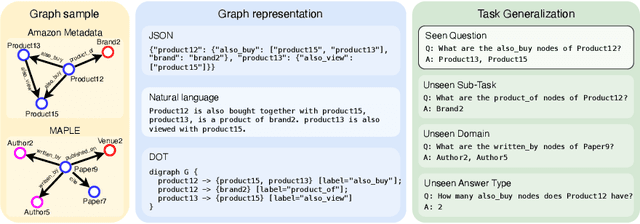
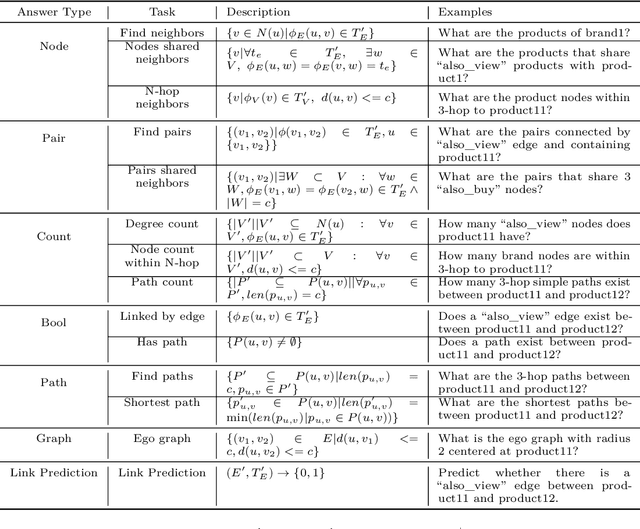

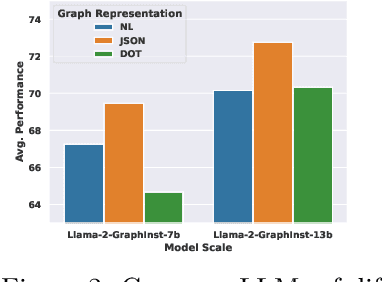
Abstract:Inspired by the recent advancements of Large Language Models (LLMs) in NLP tasks, there's growing interest in applying LLMs to graph-related tasks. This study delves into the capabilities of instruction-following LLMs for engaging with real-world graphs, aiming to offer empirical insights into how LLMs can effectively interact with graphs and generalize across graph tasks. We begin by constructing a dataset designed for instruction tuning, which comprises a diverse collection of 79 graph-related tasks from academic and e-commerce domains, featuring 44,240 training instances and 18,960 test samples. Utilizing this benchmark, our initial investigation focuses on identifying the optimal graph representation that serves as a conduit for LLMs to understand complex graph structures. Our findings indicate that JSON format for graph representation consistently outperforms natural language and code formats across various LLMs and graph types. Furthermore, we examine the key factors that influence the generalization abilities of instruction-tuned LLMs by evaluating their performance on both in-domain and out-of-domain graph tasks.
A Comprehensive Survey of Scientific Large Language Models and Their Applications in Scientific Discovery
Jun 16, 2024
Abstract:In many scientific fields, large language models (LLMs) have revolutionized the way with which text and other modalities of data (e.g., molecules and proteins) are dealt, achieving superior performance in various applications and augmenting the scientific discovery process. Nevertheless, previous surveys on scientific LLMs often concentrate on one to two fields or a single modality. In this paper, we aim to provide a more holistic view of the research landscape by unveiling cross-field and cross-modal connections between scientific LLMs regarding their architectures and pre-training techniques. To this end, we comprehensively survey over 250 scientific LLMs, discuss their commonalities and differences, as well as summarize pre-training datasets and evaluation tasks for each field and modality. Moreover, we investigate how LLMs have been deployed to benefit scientific discovery. Resources related to this survey are available at https://github.com/yuzhimanhua/Awesome-Scientific-Language-Models.
 Add to Chrome
Add to Chrome Add to Firefox
Add to Firefox Add to Edge
Add to Edge